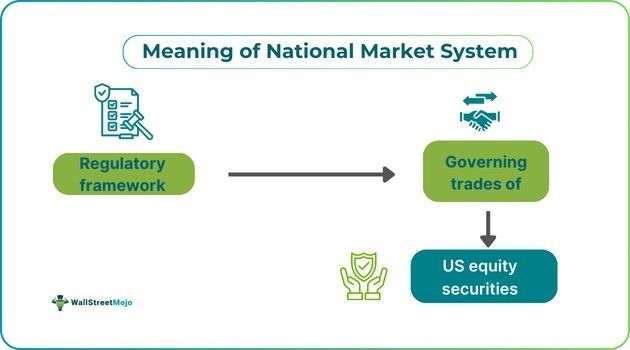Table of Contents
What Is The National Market System (NMS)?
National market system (NMS) refers to the regulatory framework developed by Congress for governing the securities and their way of operation in the United States. The main purpose of NMS is to promote transparency of the price quotations of the equity securities traded in the financial markets.

In 1975, Congress directed the Securities and Exchange Commission (SEC) to establish NMS to regulate irregularities in price quotes. The national market system includes entities and financial institutions (public and private) like stock exchanges, market price quotation providers, and trade clearinghouses engaged in buying and selling stocks are the main players.
Key Takeaways
- The National Market System (NMS) is an equity market framework for governing the securities traded in the US. It was first introduced by the Securities and Exchange Commission (SEC) in 1975.
- It promotes full disclosure of market price quotes and transparency in the trades conducted and settled on different trading venues.
- The main elements of Regulation NMS include the order protection rule, the access rule, the sub-penny rule, and the market data rule.
- However, critics also dislike the slow execution system of the NMS when looking for the lowest price quotes.
National Market System Explained
The national market system plan is a systematic, regulated framework legislation for monitoring equity securities' trade and price quotations. It ensures that there is sufficient disclosure of the market price quotes that enables equal competitive power to all investors. With the co-sponsorship of the National Association of Securities Dealers (NASD) and the NASDAQ Stock Exchange, NMS is able to oversee and foresight the securities trading in the market. It also ensures legal compliance and fair trading practices in the markets.
The foundation of an effective national market system plan dates back to the 1970s. Before the SEC began to brainstorm such an agency, the securities market was already shattered and fragmented. Instances of the same stock trading at two different prices and on different exchanges. Also, the New York Stock Exchange (NYSE) ticker failed to report transactions of NYSE stocks conducted on regional exchanges. As a result, Congress enforced the Securities Act Amendments in 1975. It paved the way for the SEC to establish the national market system law in the same year. In the later years, the rules governing NMS were updated and consolidated into regulation NMS.
On the general level, the NMS manages exchange-based trading, such as on the NYSE, and OTC (over-the-counter) trading on the NASDAQ. As a result, there is a fair supply of data to investors vesting in these platforms. In return, it builds enough confidence within investors, which also promotes liquidity and better price discovery in the market.
Purpose
The unorganized market was huge before the US national market system existed, considering securities. However, the NMS ensured a set of objectives and responsibilities for regulating the market. Let us understand the purpose of its establishment:
- Fair market competition: The prime objective of this plan was to have a fair and competitive landscape for traders to trade in. It also ensured equal and non-discriminative competition in all stock exchanges and OTC trading.
- Smooth order execution: NMS sees that the trades occur on a timely and efficient manner.
- Transparency: As a part of trade practices, the NMS ensures that there is enough transparency regarding price quotes, buy and sell, and securities transactions prevailing in the market.
- Uniform price display: Previously, different price quotes were living in trading venues. However, NMS ensures that the stocks are executed at a price best quoted for buyers and sellers.
- Direct matching of trade orders: At the same time, US national market system law also caters to the best interests of the traders and investors. Earlier, the brokers used to increase the transaction costs for the investors. But, with the electronic trading system, there is direct matching of buy and sell orders.
Regulation National Market System
The key components of the NMS include the Order Protection Rule, the Access Rule, the Sub-Penny Rule, and the Market Data Rule. Each of these elements is designed with the purpose of having a fair and competitive environment in the equity markets. Let us understand them in more detail:
- Order protection rule: Also known as Rule 611, ensures that the trades get executed at the same price (quote) at all trading venues. The effect is that the stocks are not traded at a worse price but at a competitive quote.
- Access rule (Rule 610): It enables fair and non-discriminatory access to all quotes at the trading exchanges. There is improved access to equity price quotations, which requires enough linking and lower access fees.
- Sub-penny rule: As the name suggests, this rule prevents traders from quoting prices less than a cent. It applies to all stocks at over $1 per share. Also, it prohibits any kind of manipulative trading practices due to cent difference.
- Market data rule: Lastly, the market data rule requires the financial entities to contribute and display the market information to the rest audience. It also allocates revenue to those self-regulatory organizations providing such data.
Criticism
In contrast to the various promising benefits to the equity holders, there are some criticisms against NMS as well. Critics argue that an effective national market system plan does not cater to traders wanting fast execution orders. Since this plan goes with the lowest price rule, an order placed on one trading venue executes on a venue with the lowest price. It takes time to do the same. However, it is a disadvantage for traders wishing to tap the ongoing potential of the market.
Due to transparency rules of buy and sell orders, data is publicly available to all. Furthermore, it leads to the creation of dark pools where large institutional traders hide their trade volumes. To some extent, there is an increased cost when connecting to multiple trading venues and exchanges.
